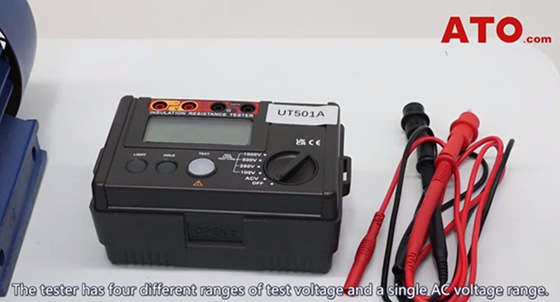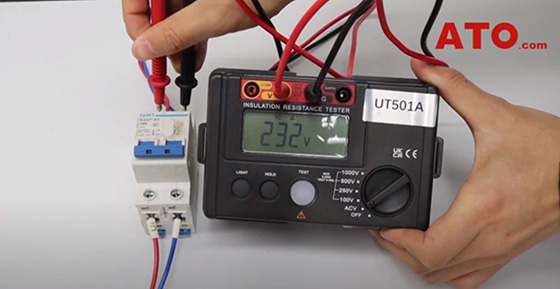Using an Insulation Resistance Tester to Test 3-Phase Motor
An insulation resistance tester is a fundamental device used to evaluate the integrity of insulation in electrical equipment, ensuring safety and reliability in various applications. This tester measures the resistance offered by insulation materials against electrical currents, helping to identify potential faults such as deteriorated insulation or moisture ingress that could lead to equipment failure or electrical hazards.
In this blog, we will guide you through using an insulation resistance tester to assess the insulation quality of a 3-phase motor and measure AC voltage, ensuring safety and reliability in electrical systems. The tester features multiple test voltage ranges and an AC voltage measurement capability.

Step-by-Step Guide
Connecting the Probes
- Insert the red probe into the LINE port and the black probe into the EARTH port.
Testing Motor Housing Insulation
- Set the tester to 500V test voltage.
- Clamp the black probe onto the motor’s shell.
- Press the TEST button and touch the motor’s casing with the red probe.
- A low resistance value close to zero indicates insufficient insulation and a risk of short circuit.
Measuring Insulation Resistance
- Connect the tester’s leads: one to the motor winding and the other to the motor casing.
- Press the TEST button to measure insulation resistance.
- A passing test typically requires at least 0.5 megohms for a 3-phase motor, and lower values indicate potential insulation faults.
Testing Other Phases
- Repeat the insulation resistance test for the remaining two phases.
- Ensure measured resistance meets recommended standards for the motor and its application.
AC Voltage Measurement
- Switch the tester to the AC Voltage range.
- Insert the red probe into the V port and the black probe into the G port.
- Directly measure AC voltage, for example, measure voltage at a power switch to verify electrical supply status.
The tester will display the measured AC voltage value, indicating the voltage present in the power source.

By following these procedures, potential insulation issues in a 3-phase motor can be identified early, ensuring safe and efficient operation of electrical systems. Additionally, the tester’s AC voltage measurement capability aids in verifying power source integrity.
For reliable insulation resistance testers and more electrical safety solutions, visit ATO.com. Safeguard your electrical systems with our range of digital testers tailored to various needs and applications.
This article summarizes the steps and benefits of using an insulation resistance tester for assessing a 3-phase motor's insulation quality and measuring AC voltage, promoting electrical system safety and functionality. If you have any further questions, you can watch the video below to learn more.

